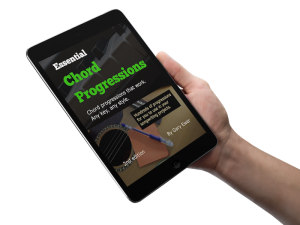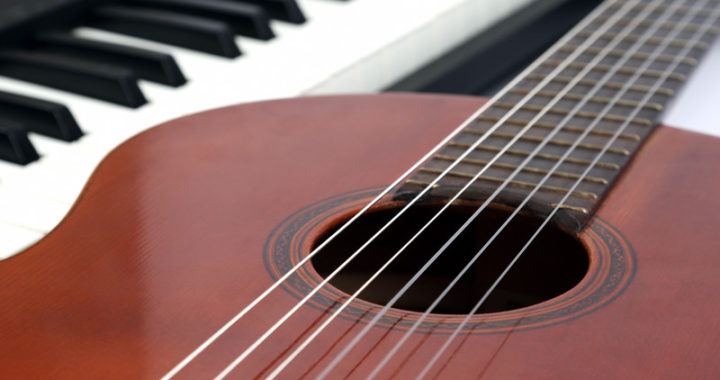If you’re bored with the chord progression you’ve come up with for your latest song, you’ll naturally want to spend some time looking for chord substitutions that sound more interesting.
But if you find that choosing new chords is a matter of random hunting, you can waste a lot of time. With a few tips, you can shorten the time it takes for you to come up with something that will suit your new melody a bit better.
“Ess ential Chord Progressions” is just one eBook in the 10-eBook Bundle that offers you lists of progressions to try. Read articles to help you understand how chords work, how to harmonize melodies, and how to apply chord progression formulas to your search for the perfect progression.
ential Chord Progressions” is just one eBook in the 10-eBook Bundle that offers you lists of progressions to try. Read articles to help you understand how chords work, how to harmonize melodies, and how to apply chord progression formulas to your search for the perfect progression.
To help you come up with new chords that might serve that melody you’re trying to harmonize, here are 8 tips to guide you:
- Though it’s not essential, it’s good if you can identify the key of your melody when choosing new chords. Most of the chords you’ll wind up using will come from one specific key, and it makes the search for possible chords a lot easier.
- If you don’t know how to identify the key of your melody, read this article.
- If you know the key, but don’t know which chords naturally belong to it, check this page.
- Remember that chords tend to change on the strong beats. So you’ll notice that most chords will change on beats 1 and 3 of every bar of music. Or if they’re held for longer, they’ll change at the start of every bar, or every second bar.
- To find a good substitute chord, focus on chords that include the melody note of any given moment. Let’s say that your song is in C major, your melody note is an E, and you had previously chosen a C chord as the one you want. To find a good substitute, you’ll want to choose a chord that includes an E. In C major, that means that your choices will likely be Em or Am.
- Don’t forget that chord extensions give you more substituting possibilities. In the previous tip, I mentioned a melody note E, and that the possible chords to harmonize it might be C, Em or Am. But chord extensions, which are the little numbers after the chord name (G7, Bbmaj7, Eb11, and so on) give you other possibilities to experiment with. That means that to harmonize the E note, you might also try: Fmaj7, Dm9, or G13. (To read more about chord extensions and how they work, read this article.
- If you use altered or non-diatonic chords (ones that don’t belong to your key), don’t allow your chord progression to stray too far from your melody’s key. Let’s say you toss in an Eb chord into your C major progression, like this: C Am Em Eb… Once you’ve used Eb, the temptation might be to stray off into some new key (…Eb Ab Bb Eb…). But that can confuse listeners. Most pop song progressions work well if you find a way to get back quickly to C major. So you might try this: C Am Em Eb Ab G C. Now the Eb to Ab acts as a momentary diversion, and you get back into C major by the end of the progression.
- Remember that the substitute chords you choose need to adhere to the principles of functional harmony. Just because a chord sounds “neat” doesn’t mean that it’s the one you should be using. Chord progressions, even creative ones, usually need to point to the tonic chord as an important anchor. Ensuring that many of the adjacent chords in your progressions are a 4th or 5th apart helps rivet the music into a key. Something like C F Dm G C works nicely because C to F, Dm to G, and G to C are all a 4th apart, finishing on the tonic chord.
- Think of a creative moment in a chord progression as a kind of “spice.” If you’re hunting for a chord substitution as a way of making your progression more interesting, you’ll find that one creative moment in your progression is probably all you need to make it sound innovative and fresh. So if you’ve got this as your progression: C F Dm G C, and you want to make it a bit more interesting, simply changing one of those chords may be all you need to do: C F Bb G C, for example.
- Innovation in your melody and lyrics is more important than innovation in your chords. I think searching for an interesting progression is great, and can be very worthwhile. But even more important than that is the work you put into creating beautifully innovative melodic shapes and ideas, and imaginative lyrics.
You’ll find that my eBook “Creative Chord Progressions” can give you even more ideas for substituting chords that you find aren’t doing it for you. (That eBook is free right now to purchasers of “The Essential Secrets of Songwriting” 10-eBook Bundle.)
 Written by Gary Ewer. Follow Gary on Twitter.
Written by Gary Ewer. Follow Gary on Twitter.
 “Hooks and Riffs: How They Grab Attention, Make Songs Memorable, and Build Your Fan Base“, is available at “The Essential Secrets of Songwriting” Online Store. Get it separately, or as part of 10-eBook Bundle, along with a FREE chord progression eBook.
“Hooks and Riffs: How They Grab Attention, Make Songs Memorable, and Build Your Fan Base“, is available at “The Essential Secrets of Songwriting” Online Store. Get it separately, or as part of 10-eBook Bundle, along with a FREE chord progression eBook.











Thanks for the great article again Gary; I really appreciate all the time and effort you put into this site! Question, what are the guidelines for choosing a chord in your progression that does not belong in your chosen key. I have a fake book and it’s incredible how many non-key chords are used and I’m a bit confused. Thanks!
When substituting a chord we should also remember the function of the chord you plan to substitute for instance Tonic Sub Dominant and Dominant, we should also be aware that certain chords can be used in a chameleon like manner , as some chords can be used in two different functions usually Tonic and sub Dominant
Every wannabe song writer needs to understand the Function of Tone